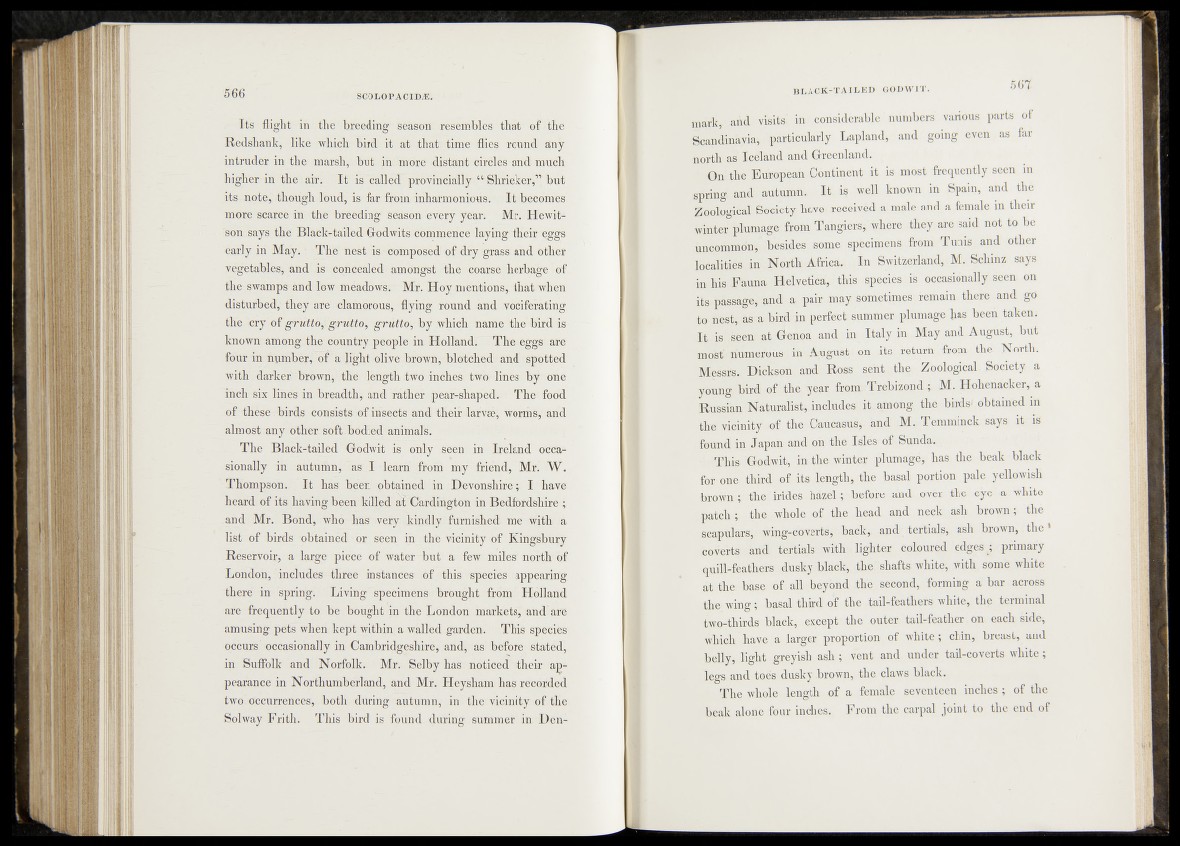
" Its flight in tfeg feeding' ^ests'e^Teseinbl^ th'ak' *of-the
-Redshank^ like whhgh? b ird 'it at that time flies round any
intruder in jh e marsh,^M^in morev distant circles and much
higher-in the:air. ff&i is callecFprovincially CtiShriek»fe but
its, note,' though loud,1 i^-far^ioin inharmonious.' It beedfobS
more scarce in th,C~'breeding Season ete^y /ysari Mr. RCtvitk
•'SoffsaysJh® Black-tailed Godwi®commence’ laymgridfeifi<,esggs
early in May. ? Thdf'^ttestn«-eom^bsM^Qf<dry*:grasssah.‘'d.other
vegetables,, and is concealed amongst the-coarse’herbage of
fhe.;swamps and low meadows. ’ Mr. Hoym$efe<tfo#s;' that when
disturbed,1, theytare clamoiqu;|^fflyirig round andi^ociferUtinjjg
the cry of grutto{, g,ruttof grutto', by which name ther*Krdjfe:-
known amongthe ^eountryjpeopltiin Holland! The^teggs are
four in numberf of'a JighiroliYeibrown/blcrtehqd and spotted
with darker “brown,l^p^dlength tropin ches' twe^linfjljby one
inch-six lines in breadth, and rather speaiWshap’ed^t The’ foo'd
nfrtllese thirds consist‘of inseefs -and tH&ifelarv®: worms,' and
almost any other soft bodied'anim'afsf!1 >;
The Black-tailedx Godwit is oUlyAleen in Ireland occasionally
in autulhn; Tas: I-learn -m ^ ^ ^ fid , Mr. W.
Thompson. It .-has _%^;gbtain‘Cpii in Devonshire'’;''I have
heard of its having been killed- at^Gardlhgto-n 'in Bedfordshire ;
.and Mr. Bond, who has' vefip^i$^|§p furnished; mC'-kith' a
list of birds -obtained for' seen in tbfe vicinity’of Kingsbury
Reservoir, a large piece of water Abut a few miles? north l l
London,. includes three instances- M: this'" species appearing
there in spring.' 1.Living"specimens11'brought from' Holland
are frequently to he bought in the London- inarkets^and-arc
amusing pets when kept within a walled garden. This species;
Occurs occasionally in Cambridgeshire, and, as'before Stated,
in Suffolk and Norfolk. Mr. Selby has. noticed their appearance
in Northumberland, and Mr. Heysham has recorded
two.-occuirenceSy. both during autumn, in’ the vicinity of.the
Solway Frith. This bird is found during summer’ in. Den-
Uïàrk, and visits! im\,considérable numbers various parts of
Scandinavia; particularly Lapland, and going even as far
north as^Ice]and and Greenland.
4^Q.n the European Continent it is most frequently seen in
spring: and autumn. I t is well known in Spain, and the
Z ©^logical Society have, received a male and a female in their
winter .plumage; from Tangiers^where they are said not to be
uncommon; besides; some. specimens from Tunis and other
localities>in North Africa, In Switzerland, M. Schinz says
in his Faun,ar Hblyeftc^ this species,, is occasionally seen on
its(*pâssâg% aùd< a pair .may- sometimes remain there and gO
to> test, as ,a bird in'perfect summer plumage has been taken.
Ibâsî,,s,eeiK at^GeSoa and in Italy in May and August, but
most' riumerogsu in .August - on its return from the North.
MeJlpk.Dickson and Ross sent, the- Zoological. Society a
^ ÿ ja '^ b ird of the year. fromrTrebizond ; M. Hohenacker, a
Russian. Nàturàlisfo includes- : it among the birds' obtained in
the1 vicinity of and M^Temminek says it is
foundin' Japan and on the Isles-off Sunda.
k-'This Gpdwit, in the winter plumage, has the. beak black
for one third of its -length, the basal portion pale yellowish
ferowm; the ' irides^hazèl ; ■ before nnd.^ver. the eye a white
patch ; the whole. of the head and neck ash brown ; the
Scapulars, wing-edv^rtsj back;: and ; tertials; ash brown, .the*
coverts, and ter-tials :;with lighter coloured edges g primary
pqaîàl-feathefs .duskyiblack, the, shafts: white, with some white
at the> base ’of all beyond the second, forming a bar across
the wing; basal third off the tail-foathers white, the terminal
two-thirds black, except the outer tail-feather on each side;
which have a larger proportion of white ; chin, breast, and
belly, light greyish ash ; vent and under tail-eoverts white ;
kgs and toes dusky .brown, the claws black.
Tb® whole length of a female seventeen inches ; of the
beak alone four inches. From the carpal joint to the end of